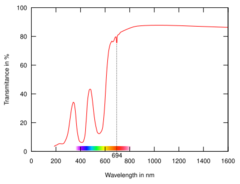Physics:Transmittance


In optical physics, transmittance of the surface of a material is its effectiveness in transmitting radiant energy. It is the fraction of incident electromagnetic power that is transmitted through a sample, in contrast to the transmission coefficient, which is the ratio of the transmitted to incident electric field.[2]
Internal transmittance refers to energy loss by absorption, whereas (total) transmittance is that due to absorption, scattering, reflection, etc.
Mathematical definitions
Hemispherical transmittance
Hemispherical transmittance of a surface, denoted T, is defined as[3]
where
- Φet is the radiant flux transmitted by that surface;
- Φei is the radiant flux received by that surface.
Spectral hemispherical transmittance
Spectral hemispherical transmittance in frequency and spectral hemispherical transmittance in wavelength of a surface, denoted Tν and Tλ respectively, are defined as[3]
where
- Φe,νt is the spectral radiant flux in frequency transmitted by that surface;
- Φe,νi is the spectral radiant flux in frequency received by that surface;
- Φe,λt is the spectral radiant flux in wavelength transmitted by that surface;
- Φe,λi is the spectral radiant flux in wavelength received by that surface.
Directional transmittance
Directional transmittance of a surface, denoted TΩ, is defined as[3]
where
- Le,Ωt is the radiance transmitted by that surface;
- Le,Ωi is the radiance received by that surface.
Spectral directional transmittance
Spectral directional transmittance in frequency and spectral directional transmittance in wavelength of a surface, denoted Tν,Ω and Tλ,Ω respectively, are defined as[3]
where
- Le,Ω,νt is the spectral radiance in frequency transmitted by that surface;
- Le,Ω,νi is the spectral radiance received by that surface;
- Le,Ω,λt is the spectral radiance in wavelength transmitted by that surface;
- Le,Ω,λi is the spectral radiance in wavelength received by that surface.
Beer–Lambert law
By definition, internal transmittance is related to optical depth and to absorbance as
where
- τ is the optical depth;
- A is the absorbance.
The Beer–Lambert law states that, for N attenuating species in the material sample,
or equivalently that
where
- σi is the attenuation cross section of the attenuating species i in the material sample;
- ni is the number density of the attenuating species i in the material sample;
- εi is the molar attenuation coefficient of the attenuating species i in the material sample;
- ci is the amount concentration of the attenuating species i in the material sample;
- ℓ is the path length of the beam of light through the material sample.
Attenuation cross section and molar attenuation coefficient are related by
and number density and amount concentration by
where NA is the Avogadro constant.
In case of uniform attenuation, these relations become[4]
or equivalently
Cases of non-uniform attenuation occur in atmospheric science applications and radiation shielding theory for instance.
Other radiometric coefficients
See also
References
- ↑ "Electronic warfare and radar systems engineering handbook". http://ewhdbks.mugu.navy.mil/EO-IR.htm#transmission.
- ↑ IUPAC, Compendium of Chemical Terminology, 2nd ed. (the "Gold Book") (1997). Online corrected version: (2006–) "Transmittance". doi:10.1351/goldbook.T06484
- ↑ 3.0 3.1 3.2 3.3 "Thermal insulation — Heat transfer by radiation — Physical quantities and definitions". ISO 9288:1989. ISO catalogue. 1989. http://www.iso.org/iso/home/store/catalogue_tc/catalogue_detail.htm?csnumber=16943.
- ↑ IUPAC, Compendium of Chemical Terminology, 2nd ed. (the "Gold Book") (1997). Online corrected version: (2006–) "Beer–Lambert law". doi:10.1351/goldbook.B00626
 |
